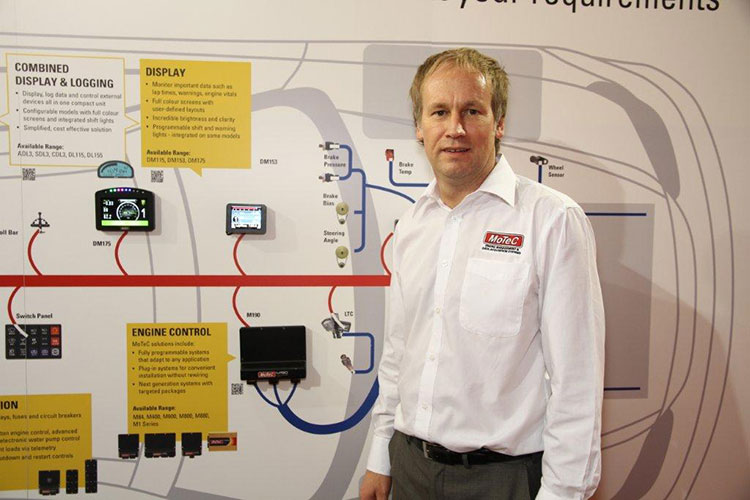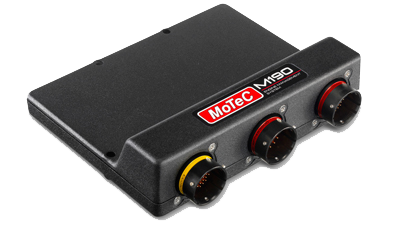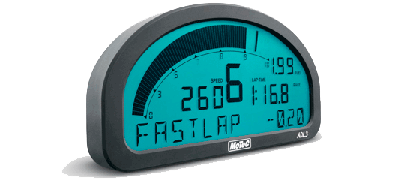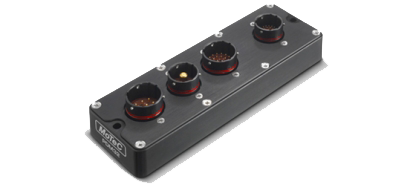
MoTeC’s motorsport commercial manager in Europe, Ross Buckingham – a name that will be familiar to many motorsport fans here in the UK and in Australia from his days racing in the Mini Miglia Championship, the British GT Championship and the Bathurst and Nurburgring 24-Hour Races – was at the 2013 UK Autosport International show and V8SCGlobal caught up with Ross to discover more about the new electronic system and Ross’ involvement in its development.
From March (2013) V8 Supercar racing moves into a new era with a new generation of cars making up the grid. Designed to maintain the category’s success over the next 10 years, the “Car of the Future” regulations involve significant technical changes which should make the cars lighter, faster, more manoeuvrable, safer and cheaper to build and run. While much of the talk has been about the introduction of a control chassis and all-new independent rear suspension system, the quest to achieve performance parity between the different Car of the Future offerings is also a crucial element and vital to achieving this is the introduction of a new high-tech integrated “control” electronic system for all the cars.
Consisting of Engine Management, Data Acquisition, Driver Display, Power Distribution, Video Capture and Accident Recorder, the control electronic system has been developed by MoTeC. A world leader in the design and manufacture of professional engine management and data acquisition solutions, MoTeC already have a long association with V8 Supercars as both an exclusive control supplier of Engine Management and as a supplier to the majority of teams who have previously chosen to use MoTeC Data Acquisition, Telemetry and Power Distribution systems.
V8SCGlobal: Can you give us a little background about MoTeC and how the company came to be involved in V8 Supercars
RB: MoTeC has had an involvement with Australian Touring Car racing dating back to when the company started in 1987. Gradually, more and more people started using MoTeC products in the old ‘Group A’ days, and then when they changed the regulations to what was then known as 5.0 litre touring cars and now known as V8 Supercars, quite a lot of teams were already using MoTeC systems. But there was a desire by the organisers to limit things like traction control and some of the driving aids that they felt would spoil the spectacle of the racing. At the same time they didn’t want to detract from the teams’ ability to tune the cars properly and maintain reliability and all those kind of things. The only way to really ban things like traction control and other types of driving aids is to have control software for the ECU [engine control unit] because if you have multiple types of ECUs available in a championship it’s very difficult to scrutinise what the car’s capable of. So, the decision was made to introduce a control ECU and MoTeC was awarded the tender which probably suited most of the teams at the time anyway as, with only a few exceptions, most were using already MoTeC systems.
That was in 2002, and they ran the M48 ECU with all the software inspected by the FIA [the governing body of motorsport worldwide]. That was used for six years until the 2009 season when they decided to run the cars on E85 fuel and wanted to incorporate some of the data that was externally logged such as the rev-limiter. With the M800 system we were able to do that as well as managing things like the rain-light on the back of the car which flashes when you’ve got the pit-lane speed limiter active. Instead of having a separate electronic box to do that, it was all handled in the M800 ECU.
For the 2013 season it’s a complete rule change. Whereas the previous iterations of the car were really an evolution, with minor changes each year that came about, this is a complete re-write of the technical regulations for the car with the aim of reducing costs and attracting other car manufacturers to the series. Control components have been used to try and keep costs down and maintain this idea of no electronic driver-aid in the cars so the cars are spectacular to watch and still reliant on the skill of the driver. So the electronic system was one of the control components along with the gearbox, some suspension components and things like that. That went out to tender and MoTeC was again awarded the tender for supplying the complete electronic system. Not just the ECU, but the data-logging system, the power distribution system and the telemetry system.
V8SCGlobal: Can you tell us about the features of the electronic system and what specifications were required to meet the tender?
RB: They had some criteria that was part of the tender document but not an actual specification, so we actually worked with V8 Supercars, and obviously because of the history we have them we had a pretty good understanding of what they wanted.  The engine will be controlled by the M190 ECU. This manages all aspects of the engine – Fuel and Ignition, RPM Limiting, Electronic Throttle Control, Gear Change Cut (for full throttle gear shifting), fuel pumps, pit lane speed limiting and several other engine related functions. The ECU’s software has been specially written to suit the requirements of V8 Supercars. This allows teams to tune the engine for maximum power, fuel economy and drivability without allowing any unauthorised strategies, such as Traction Control. The ECU is also used as a data logger by V8 Supercars’ officials to record information for scrutineering purposes. There was some new technology that they wanted to allow in there, but they also wanted to allow for possible future developments, so they wanted an ECU that was future-proof really, to allow for things like electronic throttle, the possibility of variable camshaft-control, even paddle-shift systems; not that they necessarily want to use those, but we’ve made allowances for those in the hardware we’ve chosen. So potentially if they want to do a little change in two years’ time and allow certain other features in the car, the ECU is capable and we’d just have to write the new code for the existing ECU.
The engine will be controlled by the M190 ECU. This manages all aspects of the engine – Fuel and Ignition, RPM Limiting, Electronic Throttle Control, Gear Change Cut (for full throttle gear shifting), fuel pumps, pit lane speed limiting and several other engine related functions. The ECU’s software has been specially written to suit the requirements of V8 Supercars. This allows teams to tune the engine for maximum power, fuel economy and drivability without allowing any unauthorised strategies, such as Traction Control. The ECU is also used as a data logger by V8 Supercars’ officials to record information for scrutineering purposes. There was some new technology that they wanted to allow in there, but they also wanted to allow for possible future developments, so they wanted an ECU that was future-proof really, to allow for things like electronic throttle, the possibility of variable camshaft-control, even paddle-shift systems; not that they necessarily want to use those, but we’ve made allowances for those in the hardware we’ve chosen. So potentially if they want to do a little change in two years’ time and allow certain other features in the car, the ECU is capable and we’d just have to write the new code for the existing ECU.
In effect, they have specified software requirements, although it’s been a bit of a to-and fro thing because they had ideas and in some cases they may not have been practical for various reasons, so we worked together to find a solution that suited their requirements. The software is very secure, you can’t send any other software to it to prevent teams from using any strategies that are not permitted under the technical regulations. There’s no features in there that haven’t been approved by V8 Supercars. There are four manufacturers involved in 2013, and we cater for all those with one version of the ECU software, but the ECUs are likely to be in the cars for a minimum of five years, so if there was ever a change, and there could be, such as another manufacturer getting an engine homologated that has specific requirements, it might cause us to have to deviate from that, but that would all have to be passed by V8 Supercars.
The COTF driver display and team data logger is incorporated in a single device, the MoTeC ADL3 (Advanced Dash Logger). The ADL3 has a comprehensive, programmable display and driver warning system and also stores data that the teams can download when the car is in the pits. Plus it transmits telemetry data for the teams to monitor in the pit garage while the car is out on track. Teams have the option of using a steering wheel mounted colour display.
The ADL3 can be configured to display any of the 300+ channels available within the system but is likely to include things like RPM, Gear, Fuel Level, Roll Bar Positions, Lap Time and predicted Lap Time information. This can all be customised to suit the driver. In addition, the MoTeC SLM (Shift Light Module) is used to indicate gear change points but can also be used to alert the driver to various conditions such as wheel lock up, activation of the pit lane speed limiter, tell tales for direction indicators and warning alarms. The warning alarm system is used to alert the driver to any problems that may occur, for example an overheating engine or loss of oil pressure. The use of warning alarms combined with the SLM eliminates much of the need for the driver to look at the display, allowing more focus on the actual job of driving the car.
The data system is a very important part of each V8 Supercar. Data from all areas of the car including engine, suspension, brakes and driver input is used by engineers to monitor the condition of the car, make changes to improve performance and analyse the driving style.
In addition to the data system, each car has a MoTeC Video Capture System (VCS) which is linked to the CAN Bus to integrate vehicle data on to the video. This video is used for incident investigation and to enhance data analysis.
 At the heart of the electronic system is the MoTeC Power Distribution Module (PDM32). The PDM performs the function of a traditional fuse and relay system. Instead of fuses and relays the PDM is a programmed device which controls the electrical power to everything in the car from the starter motor to the driver’s cool suit.
At the heart of the electronic system is the MoTeC Power Distribution Module (PDM32). The PDM performs the function of a traditional fuse and relay system. Instead of fuses and relays the PDM is a programmed device which controls the electrical power to everything in the car from the starter motor to the driver’s cool suit.
The PDM allows circuits to turn on either via a conventional switch operated by the driver or automatically via a set of predetermined conditions which are programmed in to the PDM. In the event of a short circuit, the PDM will switch off the power to the affected circuit to prevent damage to the wiring. Unlike a fuse, which would blow in this situation, or a circuit breaker, which would need to be manually re-set, the PDM will continually retry switching on the affected circuit so if the problem is only temporary the full operation of the vehicle is maintained. If the problem is not temporary the circuit will be switched off again until the next retry. The re-try will occur every 0.1 seconds.
V8SCGlobal:One of the key features of the Car of the Future has been to reduce costs, but it must be challenging when it comes to creating high-tech electronic systems?
RB: It is quite difficult but having a common electronic system, it means that there’s just one lot of development that has to be done for the entire field. There’s a bit of buying power there as well because we know there are 32 cars out there that are going to use our system so we can reduce costs, because we know we’re going to sell a certain amount of equipment. It also means that teams no longer have as much choice of how they configure the electronic system – well they can configure it – but the actual hardware they use is predetermined, so rather than thinking should we use two power distribution modules in the car instead of one, they don’t have that choice anymore. There’s only one model of data-logging they’re allowed to use whereas previously, there was three types of MoTeC data-logger they could’ve used and there was also a data-logger from PI, so there was a lot more scope for them to spend more money on their systems. Now they don’t have that option.
V8SCGlobal: Can you tell us a little bit more about your involvement in the development of the system
RB: I’ve done a lot of technical support with V8 Supercars over the last eight years. Fortunately, our equipment has been very reliable, but we do go along to race meetings and we do like to see the teams in the garage and make sure everything’s running smoothly. A big part of that is an opportunity for the teams to give us feedback and maybe say ‘we don’t really like the way this works’, so although we can’t touch the ECU software because it’s control thing, the data analysis, the telemetry and the power distribution module we can change, and obviously that’s evolved and improved over that time based on feedback we get from the teams. And I think that the fact we are there on the ground with them and they know they can talk to us and we’re happy to spend time to get that sort of information from them has given us a very good insight into what their requirements are. Likewise, working with the race organisers, where a big part of their job is making sure no-one is infringing on the rules or interpreting the rules in such a way they haven’t anticipated and they’re getting an advantage or it’s leading to excessive costs. Being able to talk to them and discussing how to solve some of these problems when they come up has given us a really good understanding of what’s required from the their point of view, which has not only helped us in V8 Supercars but in other categories that use our control ECU’s, for example British Superbikes and one or two other Championships. It’s allowed us to know what to expect when we get asked for this sort of thing. We’ve had all those years of learning and V8 Supercars keep a very tight control over that. Although sometimes it’s quite challenging, it’s good because we all learn from it.
